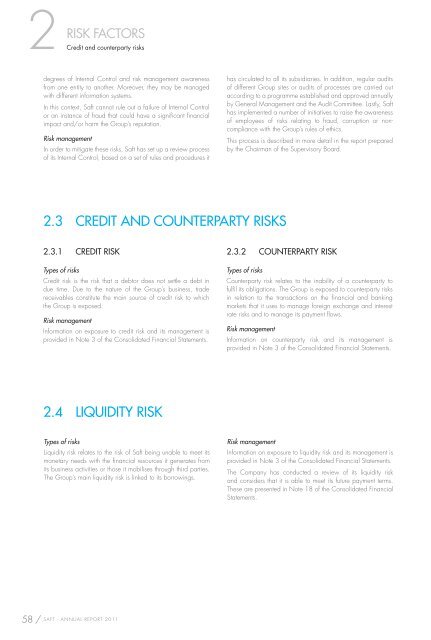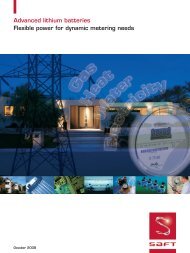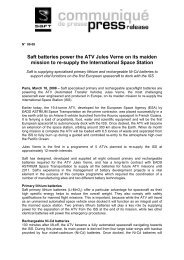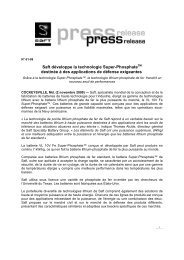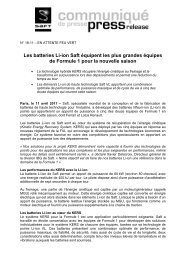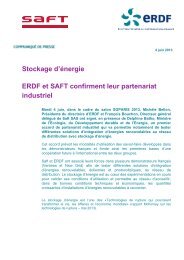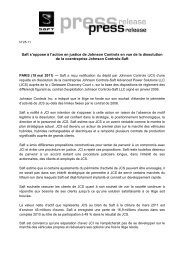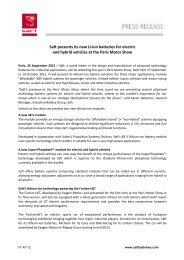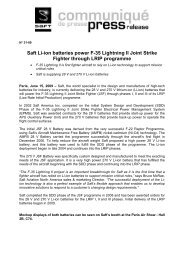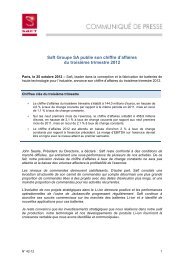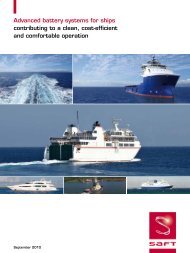ANNUAL REPORT 2011 REGISTRATION DOCUMENT - Saft
ANNUAL REPORT 2011 REGISTRATION DOCUMENT - Saft
ANNUAL REPORT 2011 REGISTRATION DOCUMENT - Saft
Create successful ePaper yourself
Turn your PDF publications into a flip-book with our unique Google optimized e-Paper software.
2 Credit<br />
RISK FACTORS<br />
and counterparty risks<br />
degrees of Internal Control and risk management awareness<br />
from one entity to another. Moreover, they may be managed<br />
with different information systems.<br />
In this context, <strong>Saft</strong> cannot rule out a failure of Internal Control<br />
or an instance of fraud that could have a signifi cant fi nancial<br />
impact and/or harm the Group’s reputation.<br />
Risk management<br />
In order to mitigate these risks, <strong>Saft</strong> has set up a review process<br />
of its Internal Control, based on a set of rules and procedures it<br />
2.3 CREDIT AND COUNTERPARTY RISKS<br />
2.3.1 CREDIT RISK<br />
Types of risks<br />
Credit risk is the risk that a debtor does not settle a debt in<br />
due time. Due to the nature of the Group’s business, trade<br />
receivables constitute the main source of credit risk to which<br />
the Group is exposed.<br />
Risk management<br />
Information on exposure to credit risk and its management is<br />
provided in Note 3 of the Consolidated Financial Statements.<br />
2.4 LIQUIDITY RISK<br />
Types of risks<br />
Liquidity risk relates to the risk of <strong>Saft</strong> being unable to meet its<br />
monetary needs with the fi nancial resources it generates from<br />
its business activities or those it mobilises through third parties.<br />
The Group’s main liquidity risk is linked to its borrowings.<br />
58 / SAFT - <strong>ANNUAL</strong> <strong>REPORT</strong> <strong>2011</strong><br />
has circulated to all its subsidiaries. In addition, regular audits<br />
of different Group sites or audits of processes are carried out<br />
according to a programme established and approved annually<br />
by General Management and the Audit Committee. Lastly, <strong>Saft</strong><br />
has implemented a number of initiatives to raise the awareness<br />
of employees of risks relating to fraud, corruption or noncompliance<br />
with the Group’s rules of ethics.<br />
This process is described in more detail in the report prepared<br />
by the Chairman of the Supervisory Board.<br />
2.3.2 COUNTERPARTY RISK<br />
Types of risks<br />
Counterparty risk relates to the inability of a counterparty to<br />
fulfi l its obligations. The Group is exposed to counterparty risks<br />
in relation to the transactions on the fi nancial and banking<br />
markets that it uses to manage foreign exchange and interest<br />
rate risks and to manage its payment fl ows.<br />
Risk management<br />
Information on counterparty risk and its management is<br />
provided in Note 3 of the Consolidated Financial Statements.<br />
Risk management<br />
Information on exposure to liquidity risk and its management is<br />
provided in Note 3 of the Consolidated Financial Statements.<br />
The Company has conducted a review of its liquidity risk<br />
and considers that it is able to meet its future payment terms.<br />
These are presented in Note 18 of the Consolidated Financial<br />
Statements.


